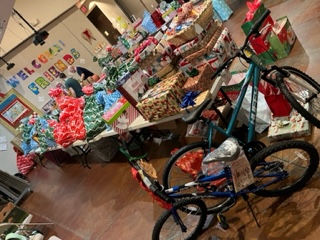Embrace of Celebrations Organize Gift Drive for Osceola County Families
- Embrace Celebration
- Dec 26, 2022
- 4 min read
Updated: Nov 9, 2023
Original Article here: https://www.mynews13.com/fl/orlando/news/2022/12/22/local-nonprofit-organizes-gift-drive-for-hundreds-of-osceola-county-kids
Spanish Coverage: https://www.telemundo31.com/noticias/local/varias-familias-en-kissimmee-no-se-quedaran-sin-regalos-esta-navidad/2171685/
Wesh News Coverage: https://www.wesh.com/article/embrace-of-celebration-kissimmee-christmas/42332155
Spectrum News 13 Coverage: https://www.mynews13.com/fl/orlando/news/2022/12/22/local-nonprofit-organizes-gift-drive-for-hundreds-of-osceola-county-kids
Over 200 Families Served This Year for Christmas.
Volunteers loaded up a U-Haul in Celebration Thursday morning — not with moving supplies, but with Christmas gifts, which will be delivered to hundreds of housing-insecure children in the area over the next couple days.
It’s the third and largest Christmas gift drive so far led by Embrace of Celebration, a nonprofit Bettina Grzeskowiak started in the summer of 2020, after seeing so many working families here struggle to make ends meet.
The group distributes fresh food and basic necessities to lower-income families every week — but this week’s holiday gift drive is extra special.
“We have Christmas wish lists, so our families fill them out and write down what they wish for,” Grzeskowiak said. “Normally, we have one book for each child and one complete outfit and a toy that they can wish for. So some kids ask for a bike, or a board game.”
Local community partners sponsored the gifts, Grzeskowiak said, including Celebration Foundation, Mattamy Homes and a local Cub Scout troop. Over the next couple days, Grzeskowiak and other volunteers will deliver the gifts to families with kids in need, including many staying in hotels along Route 192, and affordable housing units at Backlot Apartments.
They will ultimately serve approximately 400 kids between all the various locations, Grzeskowiak said. She added that whenever possible, parents will collect the gifts and give them to their kids. That way, it’s as if the gifts come from the parents, or maybe even Santa Claus.
“We have a teenager at one of the hotels — they don’t have transportation, so he asked for a scooter,” Grzeskowiak said with a grin. “I don’t know if he’s getting one. I’ll find out tonight, but that would be nice for him.”
School districts in Osceola, Seminole and Orange counties have all reported dramatic spikes in student homelessness since November of last year, according to The Homeless Services Network of Central Florida.
That data includes kids who are staying in hotels, cars, or doubling up with family and friends.
Data showed that Osceola County’s rate of homelessness among students rose 30%, compared to the same time last year. In Seminole County, student homelessness rose by 49%, and in Orange County, it rose by 52%.
Experts say part of the problem is the region’s high cost of housing, especially since the last couple of years were marked by skyrocketing rent and home insurance prices.
“We are in an area that has a much worse housing market than the rest of the country, and even the rest of the state,” said Martha Are, CEO of the Homeless Services Network of Central Florida.
Are said that those spiking student homelessness rates don’t include preschool-aged children. Families with preschool-aged children are more vulnerable to homelessness, she said, because of the high cost of childcare.
Even as Central Florida schools report a surge in student homelessness, an annual federal homelessness report published this week seemed to paint a different picture. According to that report, Florida saw the largest decrease in homelessness between 2007-2022, compared with any other U.S. state.
Importantly, though, homelessness is defined and tracked differently by different federal agencies: while the U.S. Department of Education classifies children who are couch surfing or living in motels/hotels as homeless, the U.S. Department of Housing and Urban Development (HUD) does not. Instead, HUD only counts people who are “literally homeless,” meaning they’re either staying in a shelter, or out on the streets, living somewhere not fit for human habitation, like a car.
The result is that HUD’s stricter definition of “homeless” includes a much smaller pool of people, compared with the Department of Education’s.
Are said the difference comes down to a matter of resources. While HUD makes assistance dollars available to pay for actual housing, the Department of Education’s assistance is more limited, covering things like support services and referrals for outside help. Already, HUD is only able to serve a small portion of the population it defines as homeless, she said.
“Essentially, HUD says, ‘Once you’ve shown you’ve housed everyone who’s literally homeless, then we can start working on the other groups,’” Are said.
Children experiencing homelessness and/or housing insecurity can suffer lifelong impacts, she said, including physical/mental health challenges, an increased propensity for substance abuse and a higher risk of being human trafficked.
“The impact of homelessness on children is breathtaking,” Are said. “This is just something we want to turn around. We need to continue to focus on ensuring our region has an adequate affordable housing stock, so that children and their families have safe, warm places to live.”
That’s a challenge Grzeskowiak says her nonprofit is working to solve — and she said she hopes others follow suit.
“It’s easy to get rid of poverty if we come together as a community,” Grzeskowiak said. “Like our Celebration community — I mean, look, we can only do all that we can do because of us getting together.”
Grzeskowiak said she and her community partners will keep pushing for a better world, “one family at a time.”





















Comments